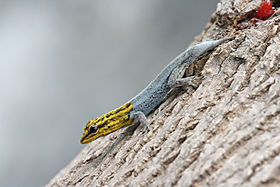Phân thứ bộ Tắc kè
Giao diện
(Đổi hướng từ Gekkota)
| Phân thứ bộ Tắc kè | |
|---|---|
| Thời điểm hóa thạch: | |
 Tắc kè lùn đầu vàng (Lygodactylus luteopicturatus) | |
| Phân loại khoa học | |
| Giới (regnum) | Animalia |
| Ngành (phylum) | Chordata |
| Nhánh | Craniata |
| Phân ngành (subphylum) | Vertebrata |
| Phân thứ ngành (infraphylum) | Gnathostomata |
| Liên lớp (superclass) | Tetrapoda |
| Lớp (class) | Sauropsida Reptilia |
| Phân lớp (subclass) | Diapsida |
| Phân thứ lớp (infraclass) | Lepidosauromorpha |
| Liên bộ (superordo) | Lepidosauria |
| Bộ (ordo) | Squamata |
| Phân bộ (subordo) | Scleroglossa Sauria |
| Phân thứ bộ (infraordo) | Gekkota |
| Các họ | |
Xem bài. | |
Phân thứ bộ Tắc kè (danh pháp khoa học: Gekkota) là một phân thứ bộ bò sát thuộc phân bộ Scleroglossa, bao gồm tất cả các loài tắc kè và họ thằn lằn không chân Pygopodidae. Các loài thằn lằn của họ Dibamidae cũng được gọi là thằn lằn không chân,[2] và từng được xem là thuộc phân thứ bộ này, nhưng nghiên cứu phát sinh chủng loài gần đây cho thấy điều này không đúng.[3][4]
Phân loại
[sửa | sửa mã nguồn]Gekkota là một phân thứ bộ của bộ Squamata, và gồm bảy họ:[5][6][7][8][9]
- Họ Carphodactylidae
- Họ Diplodactylidae
- Họ Eublepharidae
- Họ Gekkonidae
- Họ Phyllodactylidae
- Họ Pygopodidae
- Họ Sphaerodactylidae
Phát sinh chủng loài
[sửa | sửa mã nguồn]Pyron et al. (2013)[10] đưa ra cây phát sinh chủng loài như sau cho phân thứ bộ Gekkota.
| Gekkota |
| ||||||||||||||||||||||||||||||||||||
Hình ảnh
[sửa | sửa mã nguồn]Chú thích
[sửa | sửa mã nguồn]- ^ Arnold E.N., & Poinar G. (2008). “A 100 million year old gecko with sophisticated adhesive toe pads, preserved in amber from Myanmar (abstract)” (PDF). Zootaxa. Truy cập ngày 12 tháng 8 năm 2009.
- ^ Myers P. R.; Espinosa C. S. Parr, T. Jones, G. S. Hammond & T. A. Dewey (2008). “Infraorder GekkotaInfraorder Gekkota (blind lizards, geckos, and legless lizards)”. The Animal Diversity Web (online). Bản gốc lưu trữ ngày 13 tháng 5 năm 2009. Truy cập ngày 4 tháng 4 năm 2009.Quản lý CS1: nhiều tên: danh sách tác giả (liên kết)
- ^ Townsend T., A. Larson, E. Louis & J. R. Macey. 2004. Molecular phylogenetics of Squamata: The position of snakes, amphisbaenians, and dibamids, and the root of the squamate tree. Systematic Biology 53: 735–758.
- ^ Vidal N. & S. B. Hedges. 2005. The phylogeny of squamate reptiles (lizards, snakes, and amphisbaenians) inferred from nine nuclear protein-coding genes. Comptes Rendus Biologies 328: 1000–1008.
- ^ Han D., K. Zhou & A. M. Bauer. 2004. Phylogenetic relationships among gekkotan lizards inferred from c-mos nuclear DNA sequences and a new classification of the Gekkota. Biological Journal of the Linnean Society 83: 353– 368.
- ^ Gamble T., A. M. Bauer, E. Greenbaum, & T. R. Jackman. 2008. Out of the blue: A novel, trans-Atlantic clade of geckos (Gekkota, Squamata). Zoologica Scripta 37: 355-366.
- ^ Gamble T., A. M. Bauer, E. Greenbaum, & T. R. Jackman. 2008. Evidence for Gondwanan vicariance in an ancient clade of gecko lizards. Journal of Biogeography 35: 88-104
- ^ Gamble T., A. M. Bauer, G. R. Colli, E. Greenbaum, T. R. Jackman, L. J. Vitt & A. M. Simons. 2011. Coming to America: Multiple Origins of New World Geckos. Journal of Evolutionary Biology 24:231-244.
- ^ Gamble T., E. Greenbaum, T. R. Jackman, A. P. Russell & A.M. Bauer. 2012. Repeated origin and loss of adhesive toepads in geckos. PLoS ONE 7:e39429
- ^ Pyron R. A.; Burbrink F. T.; Wiens J. J. (2013). “A phylogeny and revised classification of Squamata, including 4161 species of lizards and snakes”. BMC Evol. Biol. 13 (1): 93. doi:10.1186/1471-2148-13-93. PMC 3682911. PMID 23627680.
Tham khảo
[sửa | sửa mã nguồn] Tư liệu liên quan tới Gekkota tại Wikimedia Commons
Tư liệu liên quan tới Gekkota tại Wikimedia Commons Dữ liệu liên quan tới Gekkota tại Wikispecies
Dữ liệu liên quan tới Gekkota tại Wikispecies- Phân thứ bộ Tắc kè tại trang Trung tâm Thông tin Công nghệ sinh học quốc gia Hoa Kỳ (NCBI).
- Phân thứ bộ Tắc kè tại Encyclopedia of Life
- Gekkota (TSN 564528) tại Hệ thống Thông tin Phân loại Tích hợp (ITIS).




